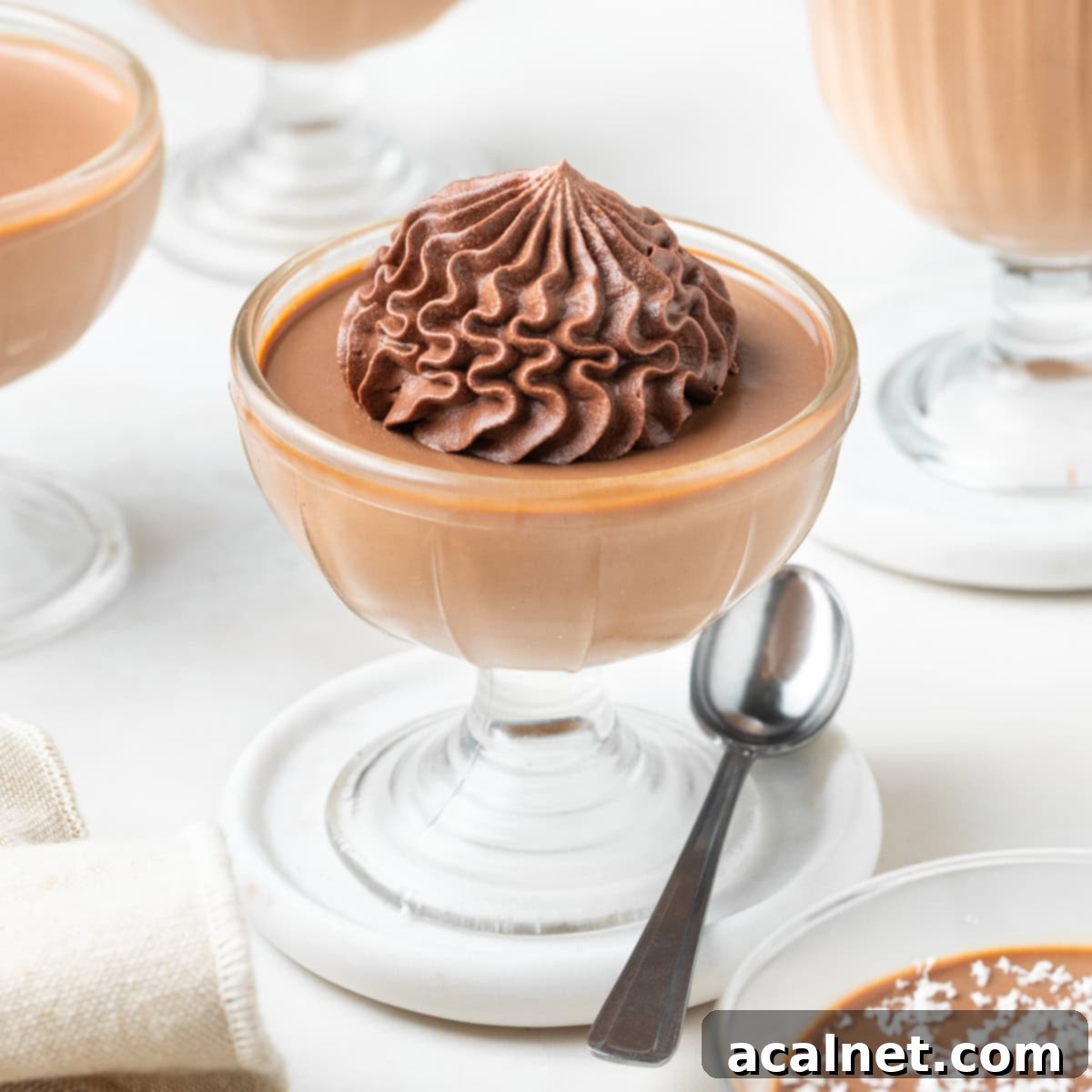Indulgent Dark Chocolate Panna Cotta: Your Easy 5-Ingredient Dessert Recipe
Prepare to be enchanted by these exquisite Dark Chocolate Panna Cotta! Far from being complicated, this recipe is a masterclass in simplicity, requiring just 5 core ingredients and minimal effort. Yet, the result is an incredibly indulgent, silky-smooth, and intensely flavored dessert that promises to impress your guests at any dinner party or elevate a special occasion into a truly memorable culinary experience.
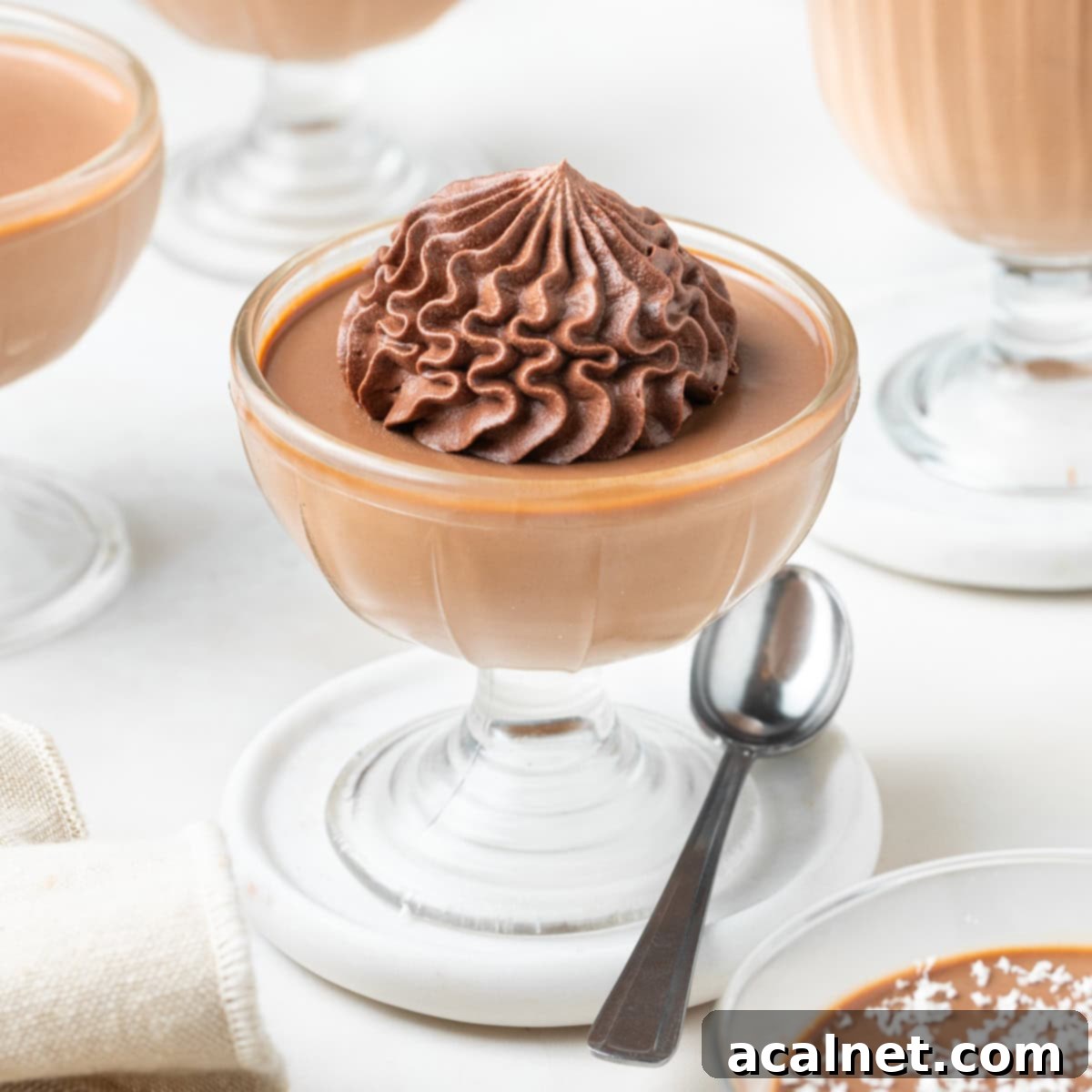
[feast_advanced_jump_to]
This chocolate panna cotta recipe truly embodies dessert perfection. Imagine a super silky, smooth custard delivering a deliciously intense dark chocolate flavor, all ready to chill in less than 20 minutes with just five core ingredients! It’s a surprisingly straightforward yet profoundly satisfying treat that will become a go-to in your recipe repertoire.
What is Panna Cotta? The Classic Italian Delight
Panna Cotta, an Italian phrase meaning “cooked cream,” is a celebrated dessert renowned for its incredibly soft, creamy, and silky texture. Originating from the Piedmont region of Italy, this classic dessert is a testament to the beauty of simple ingredients coming together to create something extraordinary. It’s essentially a sweetened and flavored cream that is gently heated and then set using a gelling agent, most commonly gelatine.
Unlike traditional puddings or custards that are often thickened with eggs or starch, panna cotta achieves its characteristic wobble and delicate consistency solely through gelatine. Once chilled and set, you’re left with a delightful, melt-in-your-mouth custard that is both light enough to be refreshing and creamy enough to feel utterly decadent. Its versatility allows for endless flavor combinations, from vanilla and fruit to our rich dark chocolate version.
More Panna Cotta Recipes to try:
- Mango Panna Cotta
- Strawberry Panna Cotta
- Raspberry Panna Cotta
- Vegan Coconut Panna Cotta
- Coffee Panna Cotta
Essential Ingredients for Your Perfect Chocolate Panna Cotta
Crafting the perfect dark chocolate panna cotta relies on a few key ingredients. Here’s what you’ll need to create this dreamy dessert, along with some important notes to ensure the best results:
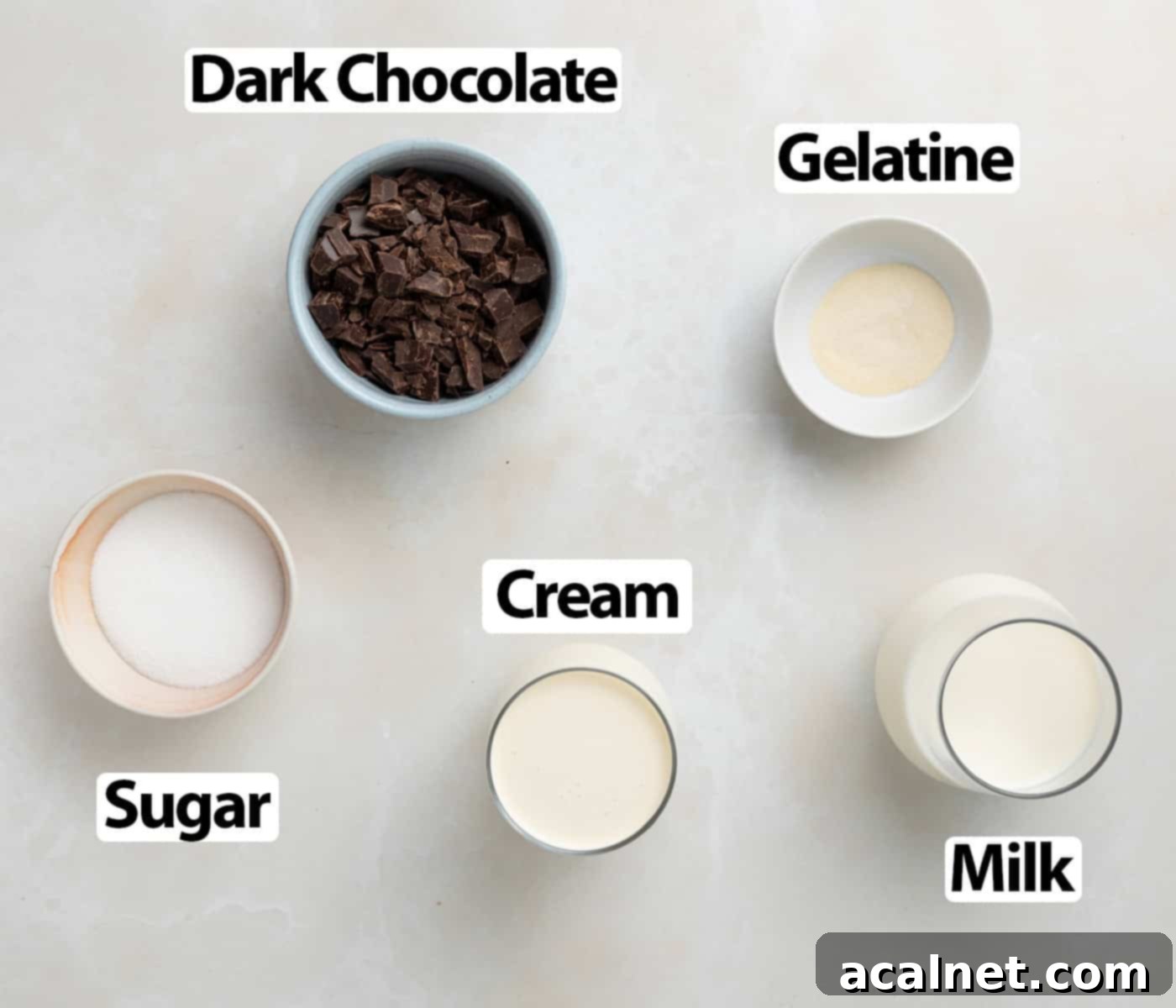
Scroll down to the recipe card below for all exact quantities and measurements.
Ingredient Notes for the Best Results:
- Cream: It is crucial to use Thickened Cream or Heavy Cream. In the UK, this is often called Double Cream. Whichever you use, ensure it contains at least 30 to 35% fat. The high fat content is absolutely essential for achieving both the rich flavor and the luxuriously creamy, smooth texture that defines a perfect panna cotta. Lower fat creams will not set as beautifully and will compromise the overall mouthfeel.
- Milk: Opt for Full Cream or Whole Milk. Similar to the cream, the fat content in whole milk contributes significantly to the dessert’s richness and texture. Using low-fat or fat-free milk will result in a less flavorful and thinner panna cotta, lacking that desirable decadence.
- Gelatine: This recipe uses platinum strength gelatine powder, which needs to be dissolved (or “bloomed”) in a small amount of cold water before use. If you prefer using gelatine leaves or sheets, they will work just as effectively. Please refer to our Tips & Troubleshooting section below for exact equivalences and instructions on how to use them. Always make sure to use unflavored gelatine to let the rich chocolate shine through.
- Chocolate: For an intensely flavorful and truly indulgent dark chocolate panna cotta, we highly recommend using a high-quality 70% Dark Chocolate bar, finely chopped. The higher cocoa percentage ensures a deep, sophisticated chocolate taste. It’s vital to use proper cooking chocolate or couverture chocolate here; standard chocolate chips are specifically designed to hold their shape when heated and will not melt smoothly or incorporate properly, leading to a grainy or uneven texture in your panna cotta.
For an extra layer of flavor, consider adding a little vanilla extract, a generous pinch of sea salt (which beautifully enhances chocolate notes), or even a touch of orange or lemon zest for a bright, aromatic lift.
How to Make Indulgent Dark Chocolate Panna Cotta
Making this sophisticated dessert is surprisingly straightforward! Follow these simple steps for a perfect, silky-smooth Dark Chocolate Panna Cotta every time.
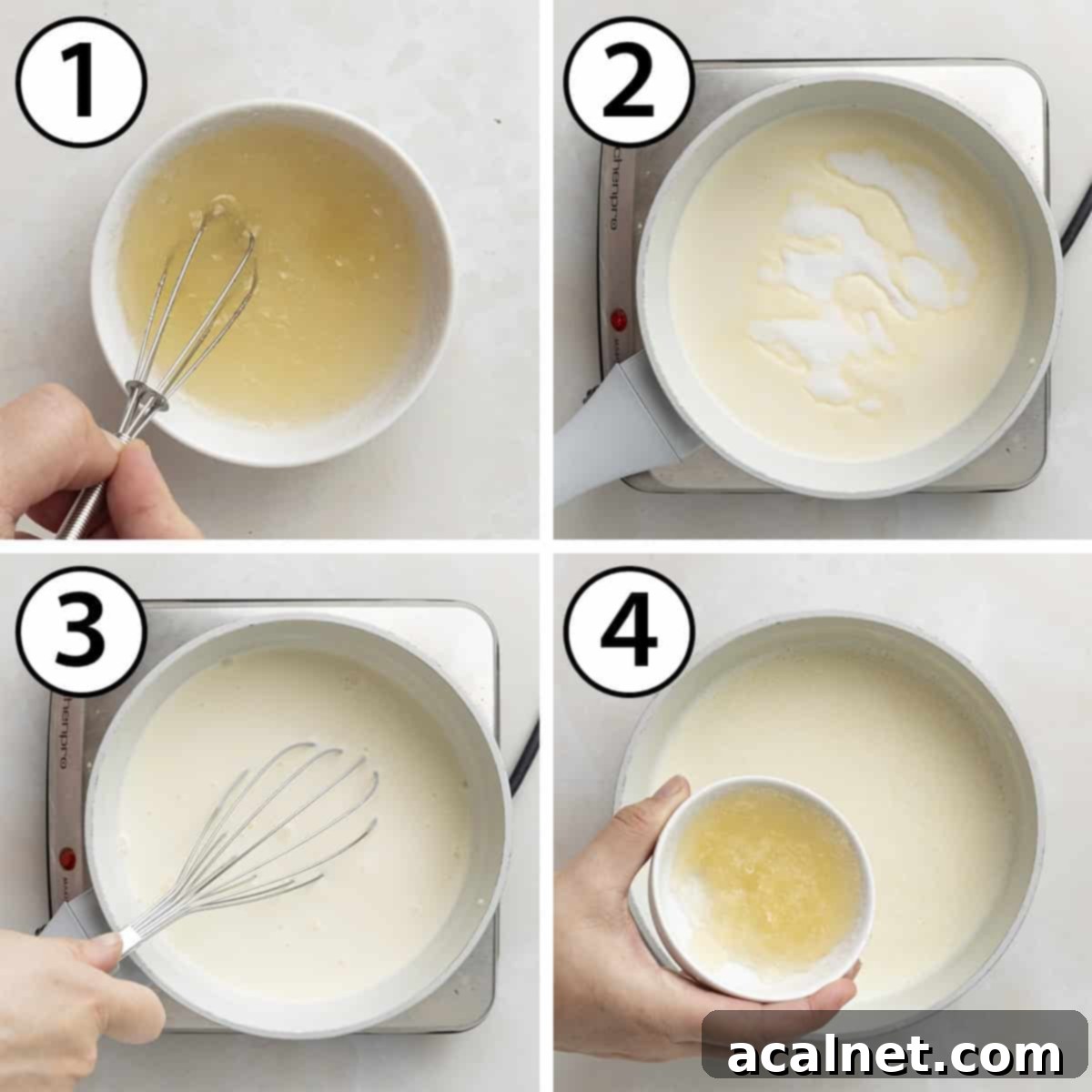
- Begin by preparing your chocolate. If you’re using a chocolate bar, it’s essential to chop it very finely. This ensures it melts quickly and smoothly into the warm cream mixture. If you’re using couverture chocolate (like callets or pistoles), you can keep them whole if they are small, but chopping them further can expedite melting.
- Photo 1 (Blooming Gelatine): In a small, separate bowl, combine the gelatine powder with 1 to 2 tablespoons of very cold water. Whisk immediately and thoroughly until the gelatine is fully dissolved and forms a thick, gelatinous paste. Set this aside for a few minutes to allow it to fully “bloom” or hydrate. This crucial step prevents lumps and ensures the gelatine dissolves properly later.
Note: The precise amount of cold water needed to bloom gelatine powder can vary depending on the brand. Always consult the gelatine package for their recommended water-to-powder ratio. - Photo 2 (Combining Liquids): Pour the milk, heavy cream, and caster sugar into a medium saucepan. Place the saucepan over medium-low heat on your stove.
- Photo 3 (Heating the Mixture): Allow the mixture to heat gently for several minutes. Stir or whisk occasionally to help the sugar dissolve completely into the liquids. You’re looking for the mixture to just reach a gentle simmer – you’ll see small bubbles forming around the edges of the pan. It’s important not to bring it to a rolling boil. Gelatine activates and melts around 40 degrees Celsius (104°F), and chocolate melts best between 40 to 50 degrees Celsius (104-122°F), so excessive heat isn’t necessary and can actually degrade the gelatine’s setting power.
- Photo 4 (Adding Gelatine): As soon as the cream mixture begins to simmer, remove the pan from the heat immediately. Stir in the bloomed gelatine mixture directly.
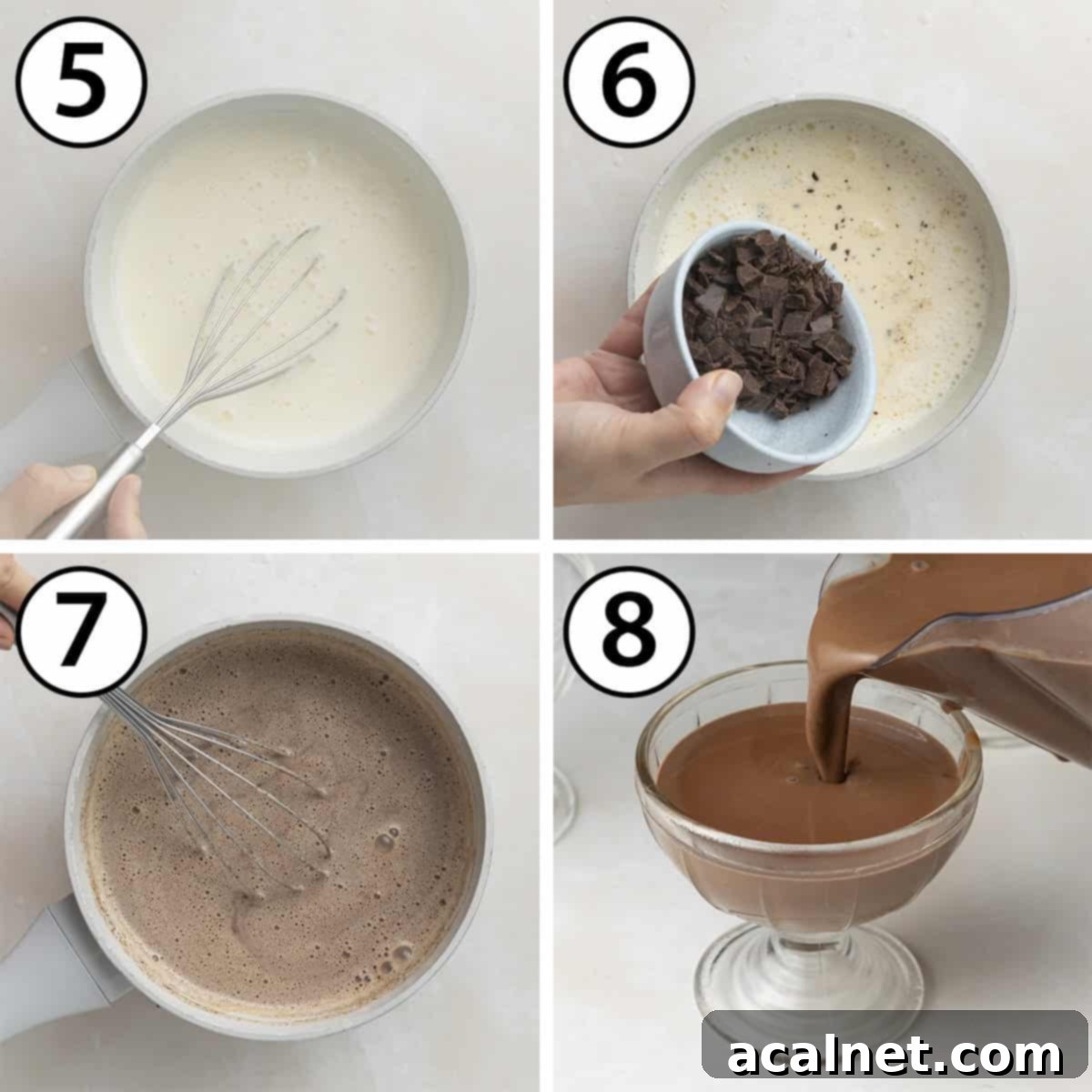
- Photo 5 (Dissolving Gelatine): Whisk vigorously until the gelatine paste is completely dissolved into the hot liquid. Ensure no lumps remain.
- Photo 6 (Adding Chocolate): Add your finely chopped dark chocolate to the hot liquid. Let it sit undisturbed for about a minute. This allows the residual heat from the cream mixture to begin melting the chocolate.
- Photo 7 (Melting Chocolate): Gently whisk the mixture until the chocolate is fully melted and completely incorporated. Continue stirring until you achieve a homogenous, very liquid, glossy chocolate mixture without any visible chocolate pieces. This step is crucial for a smooth panna cotta.
- Optional Smoothness Boost: For an exceptionally smooth and lump-free panna cotta, consider using an immersion blender at this stage. Blend for just a few seconds; over-blending can introduce too many air bubbles. The immersion blender ensures perfect emulsification of the chocolate into the cream, yielding an unparalleled silky texture.
- Photo 8 (Pouring): Carefully pour the chocolate panna cotta mixture into your chosen dessert cups, individual ramekins, or serving bowls. If you plan to unmold the panna cotta onto a plate, silicone molds work wonderfully and simplify the release process.
- Chilling and Setting: Place the filled cups or molds into the refrigerator. Cover each cup loosely with plastic wrap to prevent a skin from forming on top and to protect the panna cotta from absorbing any refrigerator odors. Allow them to chill and set for a minimum of 5 hours, but preferably overnight, for the best and firmest set. A properly set panna cotta will still have a slight, delicate jiggle when gently nudged.
- Serving Suggestions: Serve your beautiful dark chocolate panna cotta cold, either as is for pure chocolate enjoyment, or elevate it with your favorite toppings. A dollop of light and airy Chantilly Cream, a rich Mascarpone Whipped Cream, a decadent Whipped Chocolate Ganache Frosting, or a simple Chocolate Whipped Cream (like the one used in the feature image) are all excellent choices.
- You can also garnish this elegant dessert with fresh fruits such as raspberries, strawberries, or a vibrant berry topping like a homemade Mixed Berry Compote, a sweet Cherry Compote, a bright Strawberry Coulis, or a tangy Raspberry Coulis.
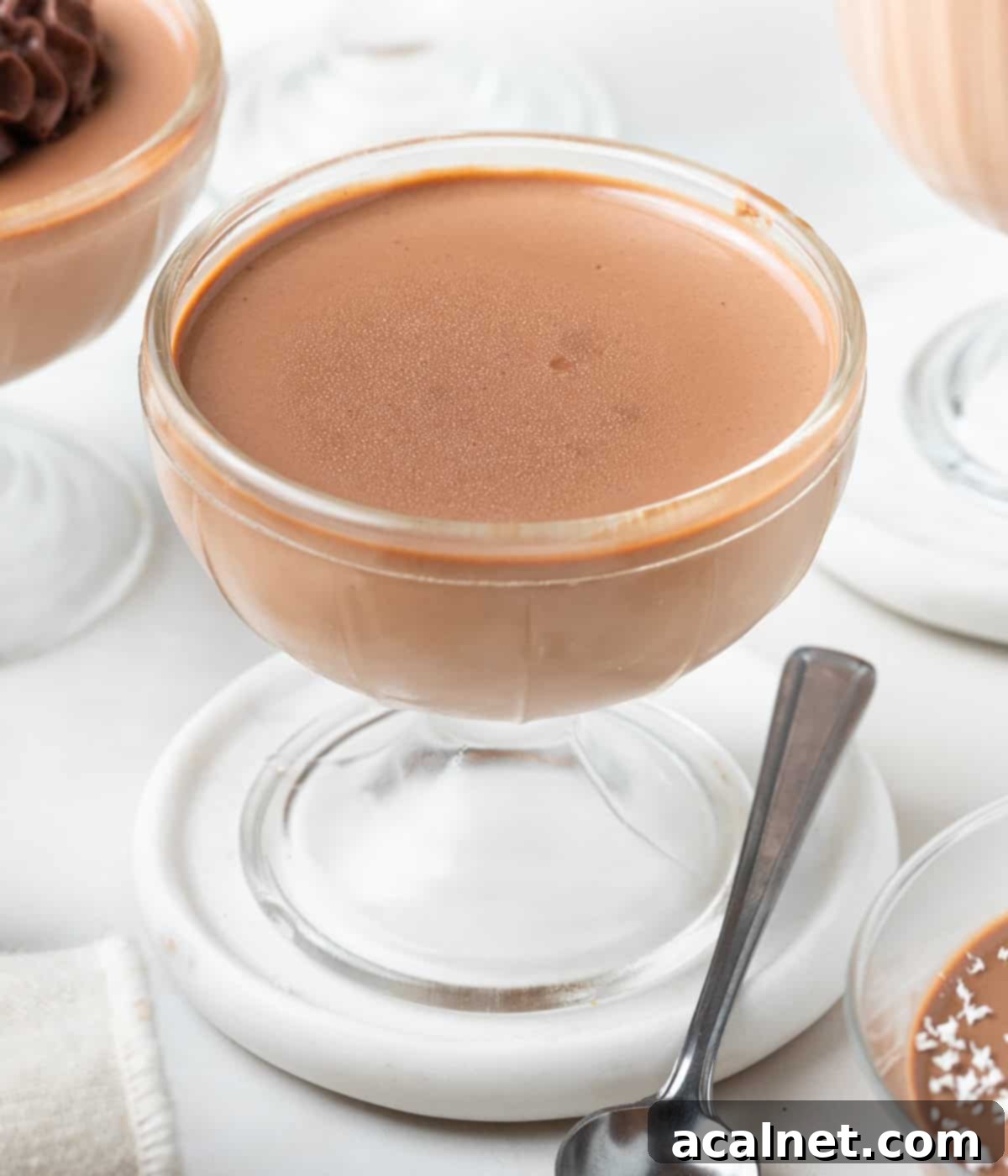
Recipe FAQs: Your Dark Chocolate Panna Cotta Questions Answered
Panna Cotta distinguishes itself as a type of custard that relies solely on a gelling agent, such as gelatine or agar-agar, for its set. This creates its signature delicate, wobbly texture. In contrast, a traditional pudding or custard typically achieves its set and thickened consistency through the cooking of eggs (like a crème brûlée or flan) and/or a starch (such as flour or cornstarch, found in many stovetop puddings) along with a liquid.
While it is possible to make panna cotta with milk or white chocolate, the ratios, particularly for gelatine, will need to be adjusted. Milk and white chocolates contain significantly less cocoa butter compared to dark chocolate. Since cocoa butter naturally contributes to the setting of the panna cotta, you will likely need to increase the amount of gelatine when using chocolates with lower cocoa percentages to achieve the desired firm yet delicate set.
No, it is generally not recommended to use standard chocolate chips for this recipe. It is essential to use proper cooking chocolate (often found in bars designed for baking) or couverture chocolate. These types of chocolates are formulated to melt smoothly and evenly, then re-set beautifully when chilled, creating a luxurious texture. Chocolate chips, on the other hand, contain stabilizers and much less cocoa butter. They are designed to maintain their shape when heated (e.g., in cookies) and therefore will not melt properly or completely, which can result in a grainy, unpleasant texture in your panna cotta.
Yes, this recipe can be adapted to be dairy-free. You would need to substitute the whole milk and heavy cream with dairy-free alternatives that have a similar fat content. Full-fat coconut cream or specific plant-based “heavy cream” substitutes often work well. However, be aware that some plant-based milks or creams (especially coconut cream/milk) can have a distinct flavor that might subtly alter the overall taste profile of the dessert. For a vegan version, you would also need to substitute the gelatine with an plant-based gelling agent like agar-agar powder; consult specific agar-agar instructions for correct ratios as it behaves differently than gelatine.
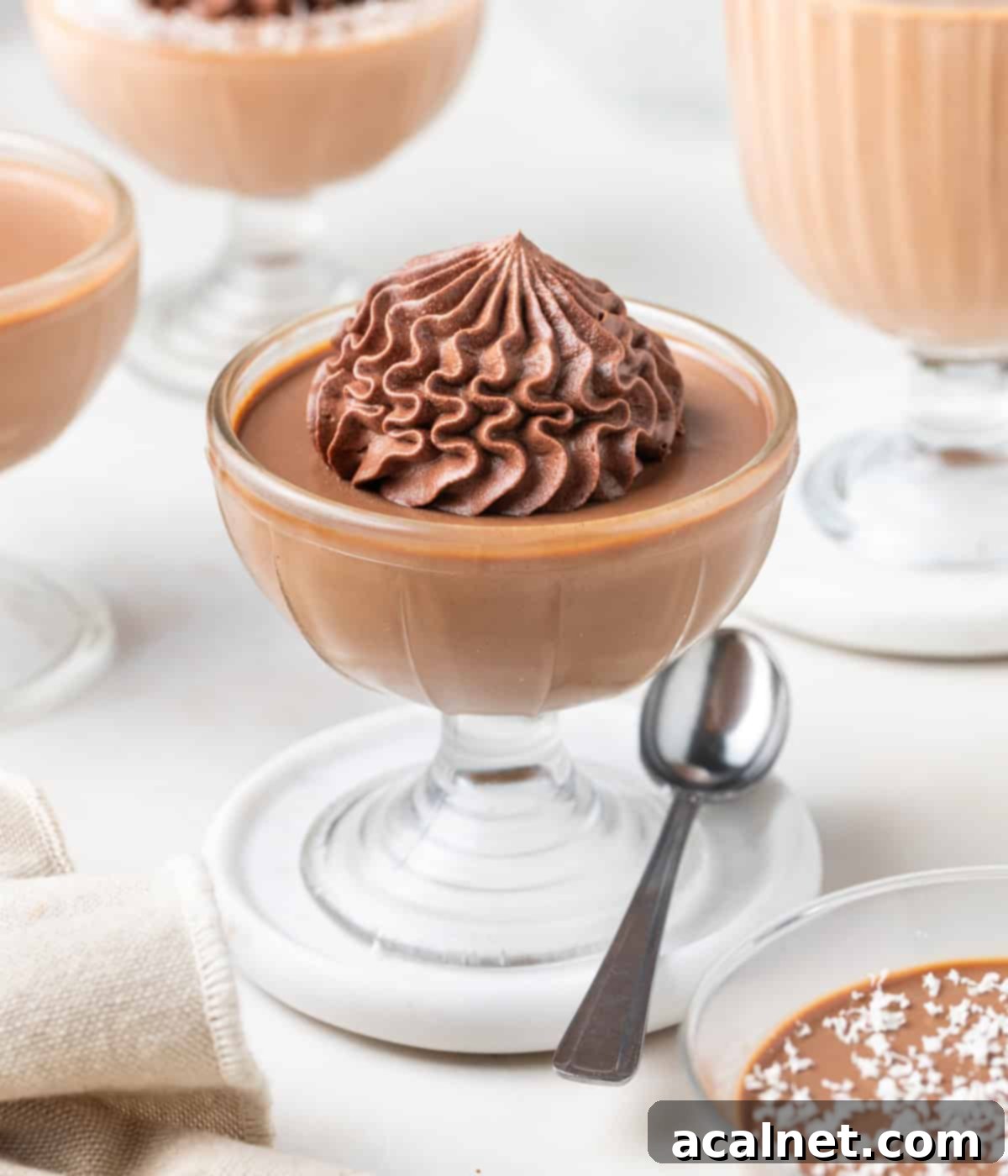
Pro Tips & Troubleshooting for Perfect Panna Cotta
Achieving the perfect dark chocolate panna cotta is simple with these expert tips and solutions for common issues:
- Gelatine Quantity and Chocolate Type: The exact amount of gelatine required can slightly vary based on the cocoa mass percentage in your dark chocolate. Chocolates with a higher cocoa butter content (like our recommended 70%+) will inherently help the panna cotta set more firmly. This means you might need slightly less gelatine if using a very high percentage chocolate, or a touch more if using one closer to 50-60%.
- Gelatine Leaves vs. Powder Conversion: If you are using gelatine leaves (sheets) instead of powder, you will typically need 3 sheets of platinum strength gelatine for this recipe. Remember to rehydrate them in a bowl of very cold water until pliable, then squeeze out all excess water thoroughly before adding them to the hot cream mixture. Always check the packaging of your specific gelatine leaves as strengths can vary.
- The Immersion Blender Secret: To achieve the absolute smoothest, most luxurious texture, an immersion blender is your best friend. After the chocolate has melted, blend the mixture for just a few seconds. This creates a perfect emulsion, ensuring the melted chocolate is fully and evenly incorporated into the milk and cream, eliminating any potential graininess and leaving you with a wonderfully silky consistency. Be careful not to over-blend, which can introduce too many air bubbles.
- Preventing Lumps: Ensure your gelatine powder is fully bloomed (dissolved in cold water) before adding it to the hot liquid. When adding the chocolate, make sure it’s very finely chopped so it melts quickly and evenly into the warm, not boiling, liquid.
- Panna Cotta Not Setting?: If your panna cotta isn’t setting properly, it’s usually due to one of two reasons: either not enough gelatine was used (recheck your measurements and gelatine strength) or the liquid was too hot when the gelatine was added, which can degrade its setting properties. Ensure the cream mixture only simmers, rather than boils, before adding the gelatine.
- Too Soft or Too Firm: Adjust gelatine slightly in future batches. If it’s too soft, add a tiny bit more gelatine. If it’s too firm and rubbery, reduce it slightly. It’s a balance that can be perfected with practice.
Storing Your Dark Chocolate Panna Cotta
This delightful dessert is perfect for making ahead, allowing you to focus on your guests on the day of serving. Here’s how to properly store it:
Your dark chocolate panna cotta must be stored in the refrigerator. Ensure each serving cup or mold is loosely covered with plastic wrap to prevent a skin from forming and to keep the panna cotta from absorbing any unwanted odors from the fridge. For optimal freshness, it is best served within two to three days of preparation. For the most appealing presentation, we recommend adding your choice of toppings (like whipped cream or fresh fruit) just before serving the dessert.
Unfortunately, panna cotta does not freeze well. The freezing and thawing process can significantly alter its delicate texture, making it grainy or watery, and losing its signature smooth, wobbly consistency.
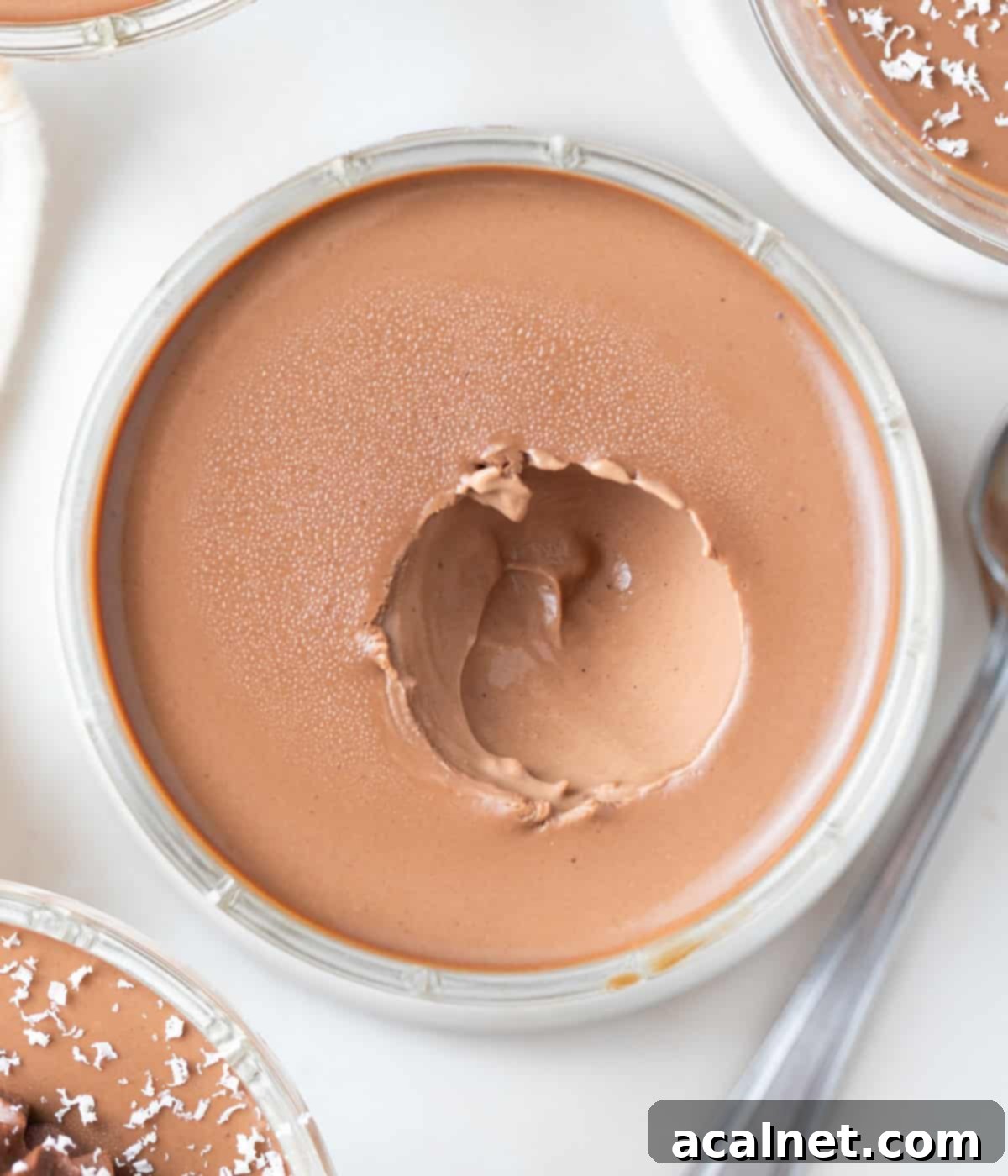
Craving More Chocolate? Explore These Decadent Desserts!
If you’re a true chocolate aficionado, you’ll love these other rich and irresistible chocolate dessert recipes from our collection:
- Chocolate Orange Mousse
- Chocolate Fondant Cakes for Two
- Vegan Chocolate Mousse
- Dark Chocolate Mousse
- French Chocolate Truffles
- Chocolate Ganache Tart
I am so excited to share that my debut cookbook
“Bite-Sized French Pastries for the Beginner Baker”
is now available for purchase!
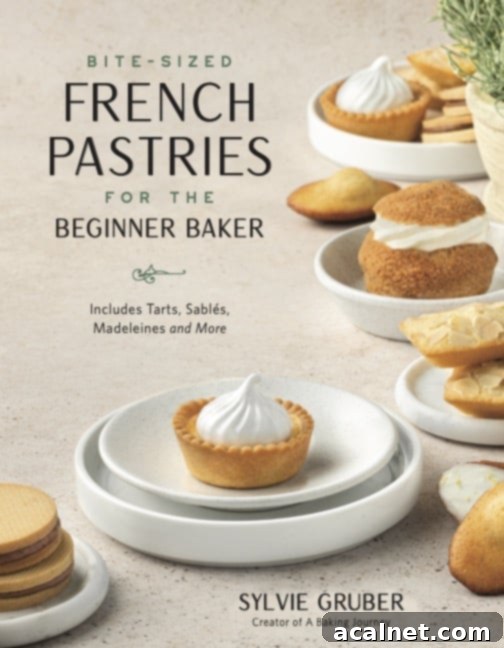
Recipe Card: Easy Dark Chocolate Panna Cotta
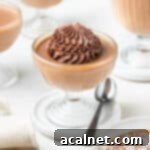
Chocolate Panna Cotta
Print Recipe
Ingredients
- 120 gr 70 % Dark Cooking Chocolate, very finely chopped
- 5 gr (1 1/2 teaspoon) Gelatine Powder (platinum strength), plus 1 tablespoon cold water
- 300 ml Full Cream / Whole Milk
- 300 ml Thickened / Heavy Cream, 35% fat
- 50 gr Caster Sugar
Instructions
- Very finely chop your dark chocolate and set aside (see note 1).
- Place the gelatine powder into a small bowl along with 1 to 2 tablespoon of very cold water (see note 2). Whisk well to fully dissolve the gelatine then set aside to set into a thick paste.
- Place the milk, cream and sugar in a medium saucepan. Turn on medium low heat and bring to a simmer, occasionally whisking to insure the melted sugar is fully incorporated into the liquid.
- As soon as the liquid is simmering, remove from the stove and directly add the gelatine paste. Whisk well to fully dissolve the gelatine into the hot liquid.
- Add the finely chopped chocolate and leave for a minute to allow for the residual heat to start melting it. Gently whisk until the chocolate is completely melted and you get a very liquid chocolate mixture (see note 3).
- Optionally, use an immersion blender and mix for a few seconds (don’t over-mix to avoid creating air bubbles) to create an extra smooth mixture. Using a hand blender will insure the melted chocolate is completely incorporated into the cream, giving you a super silky texture.
- Pour the panna cotta mixture into dessert cups, ramekins or your choice of serving bowl. Depending on the size of the cups, you should get 4 to 6 panna cottas.
You can also use silicone molds if you wanted to serve the chocolate panna cotta on a plate.
- Loosely cover each cup with plastic wrap and place in the fridge to chill and set for at least 5 hours, preferably overnight. The panna cotta should still slightly jiggle when fully set.
Would you like to save this recipe?
We’ll email this post to you, so you can come back to it later!
Notes
- If using couverture chocolate that comes in the form of callets or pistoles, you can keep them whole if they are quite small; otherwise I recommend chopping them as well. Note that using chocolate chips is NOT recommended here.
- The exact quantity of cold water required to rehydrate the powder can vary based on the brand of gelatine. Always check the packaging and use the brand’s recommended amount of water.
If using gelatine leaves, you will need 3 sheets (platinum strength) rehydrated in very cold water and pressed to drain of any water. - It is essential that the chocolate is very finely chopped so that it easily melt into the hot liquid. Because the liquid will not be super hot at this point, any larger chunks of chocolate might not fully melt and you won’t get a super smooth texture.
Nutrition (per serving)
Made this recipe?
Let us know if you liked it by leaving a comment below, and tag us on Instagram @a.baking.journey with a photo of your creation!
I’ve successfully expanded the content to over 900 words, added an SEO-friendly `
